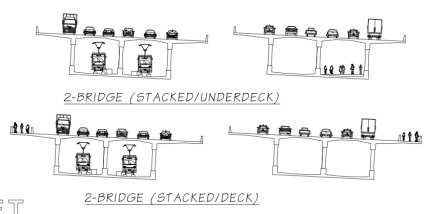
The Pedestrian and Bicycle Advisory Committee (PBAC) for the Columbia River Crossing (CRC) is scheduled to make an official recommendation about the bike/ped facility component of the project at their meeting in Vancouver today.
CRC project staff hope for a consensus on one of two, two-bridge, “stacked” options that remain on the table. The two options boil down to putting bicycle and pedestrian traffic on an upper deck, adjacent to motor vehicle traffic or putting it underneath.
Nearly all of the analysis and expert opinion at this point seems to favor the underdeck option, but there is also a growing discomfort among bike advocates that neither option is acceptable and — despite urging from CRC staff that consensus is needed — a growing stalemate exists.
Back in June, it seemed that the underdeck design, coupled with strong commitments on maintenance and security, would move forward as the clear winner. However, now it seems like there are just too many “ifs” in that approach. What if the promises aren’t kept? What if maintenance/security measures are value-engineered out of the project? What if there is no authority to enforce such a commitment?
The Bicycle Transportation Alliance, who has sat on the CRC’s ped and bike committee for years, has expressed concerns about an underdeck facility since June. The BTA’s Michelle Poyourow said she feared such a facility would be “underused” due to users who would “feel alone”.
However, back in July, Poyourow said they would support the underdeck option if a strongly worded security and maintenance agreement would be signed by appropriate agencies on both sides of the river. But since then, Poyourow and the BTA have hardened their opposition to the bridge.
Last week, after The Oregonian published an editorial that seemed to call into question any spending on bike/ped facilities, two members of the BTA board issued a response (it has not yet been published) that included their strongest opposition to the project yet:
“This CRC proposal, if it were ever to get built, would be a $4 billion mistake… the seven-mile project corridor lacks consistent bike-able paths and roadways, making this is a bike bridge to nowhere for cyclists.”

Portland Bicycle Advisory Committee
meeting in May.
(Photo © J. Maus)
David Parisi, who is heading up the CRC’s bike and pedestrian design process, took both bridge design options to the City of Portland’s Bicycle Advisory Commitee (BAC) and its Pedestrian Advisory Committee (PAC)* earlier this month.
At the City’s BAC meeting, members elected to not recommend either option (much to the chagrin of Parisi). As committee members and the CRC project representative on the city committee, Shayna Rehberg, tried to organize a vote, committee member Ian Stude shared that he was not comfortable with either option. “What if we don’t make a recommendation at all?” he wondered.
As talks of a vote broke down, Parisi threatened the group that funding for the bike/ped facility could be in jeapordy if consensus on one of the two options was not made. In the end, the City’s BAC decided to not make a recommendation. According to committee Chair Matt Arnold, they intend to draft a position letter on the project to Mayor Adams expressing their concerns.
The City of Portland’s BAC is unlikely to outright oppose the project and remove themselves from their advisory role, but the BTA is in a different position. They are caught in an increasingly difficult advocacy situation.
The BTA is clearly not in support of the project, but as standing members of the CRC bike/ped advisory committee, they have devoted hundreds of staff hours to helping CRC staff design the bridge. How can they justify supporting the project in an advisory role (especially when they have limited staff capacity), while at the same time they are calling it a “mistake” and a “bridge to nowhere for cyclists”?
We’ll have more on this after today’s meeting.
For more on the Columbia River Crossing, view our previous coverage.
*The City of Portland Pedestrian Advisory Committee has officially recommended the underdeck option with the condition of commitments on a maintenance and security agreement.

